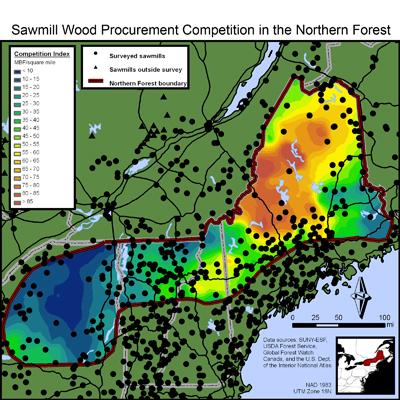The Parcelization of Private Forestlands in the Northern Forest and Its Impact on Economies of Scale for the Region’s Sawmills and Loggers

The Northern Forest is a critical source of sawlogs for sawmills in the United States and Canada. Land use change, including development and urbanization, poses challenges to the long-term wood supply for mills in this region. Few data are available to characterize wood procurement on a regional scale, making it difficult to anticipate the effects that socioeconomic and land use changes will have on wood supply and the profitability of the primary forest products industry.
NSRC researchers surveyed American and Canadian sawmills within 100 miles of the Northern Forest about procurement operations. Using spatial analysis, researchers mapped the mills’ wood procurement regions, or woodsheds, in the Northern Forest. The greatest woodshed overlap was in northern Vermont and southern Maine. However, the highest wood procurement pressure was in western and northern Maine.
The 211 United States mills responding to the survey accounted for 1.2 billion board feet of log procurement in 2005. These mills procured 90% of their wood within 30 to 70 miles of the mill but often ranged 200 miles or more to meet requirements. Over one third of the 1.1 billion board feet of procurement reported by surveyed Canadian mills originated in the United States. Canadian mills routinely range 150 miles or more to meet procurement requirements. Most mills reported that quality of logs available and average volume per log declined between 1994 and 2005. Furthermore, 64% of respondents reported a decline in average parcel size of private forest ownerships over that period. These results may indicate that the sawlog resource is declining in the region and will be further impacted by development trends.
Download printable version [PDF]
Download full final report [PDF]
